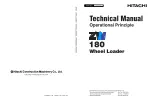
Operation
Refer to your traction unit
Operator’s Manual
for more
information on installing and removing attachments
on your traction unit.
Important:
Always use the traction unit to lift and
move the attachment.
Digging a Trench
1. If your traction unit has a speed selector, set it to
the slow (turtle position), then start the engine.
2. Pull the auxiliary hydraulics lever to the operator
grip to engage the trencher.
3. Slowly lower the trencher to the ground so that the
boom and chain are parallel to the ground.
4. Begin inserting the nose of the boom and chain
into the ground by slowly raising the trencher a few
inches off the ground while tilting the nose down
into the ground gradually.
5. Once the trencher boom is in the ground at a 45 to
60 degree angle, slowly lower the trencher until the
spoils auger is just above the ground.
6. Ensure that all parts of the trencher are functioning
correctly.
7. Slowly move the traction unit rearward to extend
the trench.
Note:
If you move too fast, the trencher will stall.
If it stalls, raise it slightly, slowly drive forward, or
reverse the chain direction momentarily.
8. When finished, raise the trencher and boom out of
the trench by tilting the attachment rearward, then
stop the trencher by moving the auxiliary hydraulics
lever into neutral.
Offsetting the Trencher
You can move the trencher to the right side of the
trencher frame to allow you to trench close to buildings
and other obstacles.
1. Lower the trencher to the ground, stop the engine,
and disconnect the hydraulic lines from the trencher.
WARNING
Hydraulic fluid escaping under pressure can
penetrate skin and cause injury. Fluid injected
into the skin must be surgically removed within
a few hours by a doctor familiar with this form
of injury or gangrene may result.
•
Keep your body and hands away from pin
hole leaks or nozzles that eject high pressure
hydraulic fluid.
•
Use cardboard or paper to find hydraulic
leaks, never use your hands.
2. Remove the 6 bolts securing the trencher head to
the frame (Figure 7).
G008937
1
2
3
Figure 7
1.
Trencher head (simplified
for illustrative purposes)
3.
Side hose guide
2.
Safety bar
3. Move the frame to the left, aligning the holes in the
right side of the frame with those in the head.
4. Attach the head to the frame with the 6 bolts
removed previously (Figure 7).
5. Torque the bolts to 190 to 230 ft-lb (257 to 311
N-m).
6. Remove the 3 bolts, washers, and flange nuts from
the safety bar and remove the bar (Figure 7).
7. Remove the 2 short bolts, washers, and flange nuts
securing the right side of the upper frame and
move them to the corresponding holes on the left
(Figure 7).
8. Install the safety bar over the trencher chain using
the 3 bolts, washers, and flange nuts removed
previously (Figure 7).
9. Torque all 5 bolts and nuts to 190 to 230 ft-lb (257
to 311 N-m).
10. Move the hoses from the hose guide on top of the
trencher to the hose guide on the left side (Figure 7).
9




















